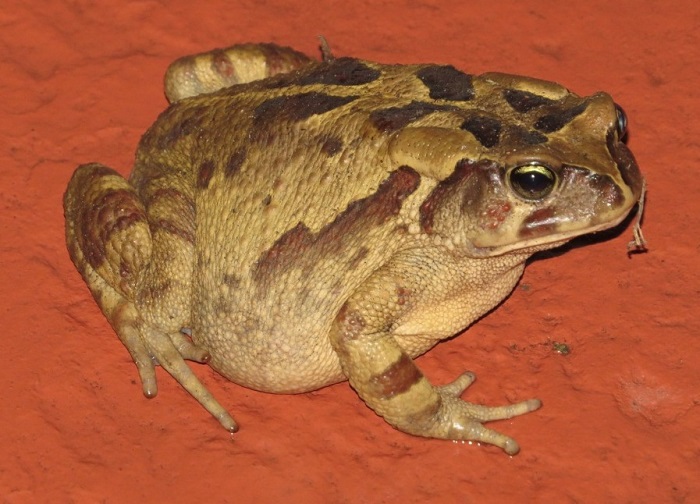View the above photo record (by Gregg Darling) in FrogMAP here.
Find the Eastern Leopard Toad in the FBIS database (Freshwater Biodiversity Information System) here.
Family Bufonidae
EASTERN LEOPARD TOAD – Sclerophrys pardalis
(Hewitt, 1935)
Habitat
S. pardalis inhabits grassy or open bushveld areas, parks and gardens in the Thicket, Grassland and Savanna biomes, and uses large, permanent water bodies for breeding (Lambiris 1989a). It appears to prefer ecotonal habitat with moist cover. Records from Stutterheim and Woody Cape are close to patches of Afromontane Forest and Coastal Forest, respectively. The south coast populations may occur, to a limited extent, in fynbos vegetation types.
Behaviour
Like its western counterpart, S. pardalis is a late-winter or spring breeder. Choruses are typically heard from August to September, but calling is also recorded from November through to January (Burger 1997). Channing (2001) also noted calling in November. Calling behaviour was studied by Passmore (1977b) who confirmed earlier reports that this large toad usually calls while floating in the water in a manner similar to Schismaderma carens. Lambiris (1989a) noted that in Grahamstown, males call in water deeper than 80 cm while grasping emergent vegetation with one hand.

Photo by Luke Kemp
This is the largest southern African bufonid attaining a snout–vent length of 147 mm and a mass of 410.7 g (Branch 1995). Captive specimens feed readily on crickets, grasshoppers, small mice (pers. obs.) and lizards (Channing 2001). It is presumed that they feed on a variety of arthropods in the wild.
Status and Conservation
This species has been recorded from Addo Elephant National Park (Branch and Braack 1987), Groendal Wilderness Area, Thomas Baines Nature Reserve and Woody Cape Nature Reserve, and is likely to occur in several other protected areas. S. pardalis is assigned to the category Least Concern (Harrison et al. 2001; this publication).
Although it may still be common at some localities, the impact of agricultural and urban development has led to fragmentation and degradation of this species’ habitat, a reduction in population numbers and possibly even local extinctions. During the breeding season, large numbers are killed by motor vehicles on roads situated near wetlands: for example, 113 S. pardalis were killed in one night along an 8-km stretch of road near Port Elizabeth (Branch 1980). The conservation actions recommended for S. pantherinus would also be appropriate for S. pardalis, especially in built-up areas.

Photo by Cobus Elstadt
Distribution
Until recently, S. pardalis was regarded as having a disjunct distribution, with one population restricted to the southwestern coastal areas of Western Cape Province and the other confined, mainly, to Eastern Cape Province (see map in Passmore and Carruthers 1995). However, the western population was raised to the status of a full species, Sclerophrys pantherinus, by Poynton and Lambiris (1998) on the basis of morphological differences, a decision supported by Eick et al. (2001; see S. pantherinus species account for further discussion).
S. pardalis is nearly endemic to the Eastern Cape Province with only a few records in the Western Cape and KwaZulu-Natal. The isolated record from Albert Falls (2930AD) in KwaZulu-Natal (Lambiris 1989a, 1994) requires confirmation by acoustic or genetic studies.
This toad is most common along the coast from Port Elizabeth northwards to East London. Inland records include Grahamstown, Kei Road (the type locality) and Stutterheim. Branch (1990) also recorded it from the Amatola Mountains and Katberg area. A recent record from Umtata (3128DB) represents another interesting, apparently isolated, population. Similarly, the recent Karatara (3322DD) and Knysna (3423AA) records are interesting in that they confirms the southwestern limit of the species’ range in the vicinity of Wilderness (Branch and Braack 1987). The atlas data are accurate but incomplete.

Further Resources
Virtual Museum (FrogMAP > Search VM > By Scientific or Common Name)
More common names: Oostelike LuiperdSkurwepadda (Afrikaans)
Recommended citation format for this species text:
Burger M, Tippett RM. Eastern Leopard Toad Sclerophrys pardalis. BDI, Cape Town.
Available online at http://thebdi.org/2021/12/20/eastern-leopard-toad-sclerophrys-pardalis/
Recommended citation format:
This species text has been updated and expanded from the text in the
2004 frog atlas. The reference to the text and the book are as follows:
Burger M 2004 Sclerophrys pardalis Eastern Leopard Toad. In Minter LR
et al 2004.
Minter LR, Burger M, Harrison JA, Braack HH, Bishop PJ, Kloepfer D (eds)
2004. Atlas and Red Data Book of the Frogs of South Africa, Lesotho and
Swaziland. Smithsonian Institution, Washington, and Avian Demography
Unit, Cape Town.

